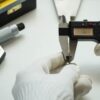
Future wearable electronic clothing could be charged by our own body heat
Thanks to rapid computing developments in the last decade and the miniaturisation of electronic components, people can, for example, track their movements and monitor their health in real time by wearing tiny computers. Researchers are now looking at how best to power these devices by turning to the user’s own body heat and working with garments, polka dots and know-how from the textile industry.
The wearable electronics market is expected to grow to €53bn by 2025, but it is dominated by one product – smartwatches. Outside of this, there are many products in ‘starting position’, said Dr Matthias Fahland of the Fraunhofer FEP in Germany. One of the field’s main obstacles is storage. ‘The question of where the energy is coming from, where the battery is, how long it will last, (storage) is the crucial question for everything.’
A project called ThermoTex is exploring the use of human body heat to power tiny devices. The thermoelectric effect has been known for almost 200 years, according to Professor Christian Müller of Chalmers University of Technology in Sweden. This effect allows heat energy to be converted into electrical energy when there is a temperature difference, such as the difference between a person’s skin and the outside temperature. Electrons move from the hotter part of a material to the cooler one, and this movement of charge generates an electric potential.
‘Heat gradients (differences) are an important power source because they are always there,’ he said.
Read more here...






Future wearable electronic clothing could be charged by our own body heat 0 reviews
Login to Write Your ReviewThere are no reviews yet.